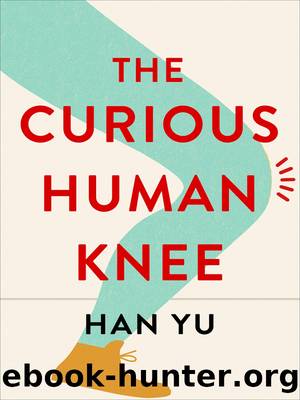The Curious Human Knee by Han Yu;

Author:Han Yu;
Language: eng
Format: epub
Tags: SCI036000, Science/Life Sciences/Human Anatomy & Physiology, SCI100000, Science/Natural History
Publisher: Lightning Source Inc. (Tier 3)
Published: 2023-06-06T00:00:00+00:00
At the sprawling Xipamanine market in Maputo, Mozambique, where thirty-some-year-old Mario makes a living selling secondhand jeans, no one likes to buy them ripped.110 Mario purchases his jeans in one-hundred-pound bales coming in as container shipments from North America and Europe. The bales are sold âblindâ: sealed and unopened. If Mario is lucky, he gets gently used ones that will fetch good prices. If not, he gets them ripped, scuffed, and stained. The dirtiest and most torn ones wonât sell, and Mario will end up losing money if his bales contain too many pairs like that.
Might some of these unwanted pairs be distressed jeans that were deliberately ripped, torn, and stained, I canât help wondering. And if so, can Mario tell, and will his Mozambican customers appreciate them as fashion? Probably not.
For Western consumers to deliberately distress clothes, using cheap labor from developing countries, and then dispense with the garments at a charity store, the irony would go full circle. Chances are that your unwanted jeans wonât make their way to the local shelter. Instead, they will be sorted, packaged, and sold back to developing countries, for a profit. Globally, about four million metric tons of old clothes are exported annually, which are equivalent to seven-and-a-half billion pairs of jeans and valued at more than $4 billion.111
Many of these clothes find their way to Africa, to places like the Xipamanine market in Mozambique. This country alone imports $55 million of used clothes a year, which is fifty-two thousand metric tons of garments, or the equivalent of ninety-nine million pairs of jeans.112
These secondhand clothes provide impoverished Africans with a cheap source of clothing, at the expense of style and preference. And so it is that in Maputo, it is common for men to wear ladiesâ trousers, and in Uganda, a Karamoja elder would attend a tribal ceremony wearing nothing but a womanâs tweed, oatmeal-colored winter overcoat.113
These secondhand clothes provide Mario and thousands of used-clothes traders in Africa a precarious small business to keep their heads above waterâbut never to escape poverty. The traders face the constant dilemma of risking money on another blind bale or using it to provide for their families, or, indeed, to save money to pay for education toward a better-paying job.114
These secondhand clothes, along with cheap new garments coming in from East Asia, outcompete Africaâs domestically manufactured garments, chocking to death the local industry and the prospect of economic growth, the hope of escaping distressed clothes.115
In fashion as in health, money, race, power, and status all matter. Our knees, curiously enough, provide a glimpse of that reality.
Download
This site does not store any files on its server. We only index and link to content provided by other sites. Please contact the content providers to delete copyright contents if any and email us, we'll remove relevant links or contents immediately.
Sapiens: A Brief History of Humankind by Yuval Noah Harari(14045)
The Tidewater Tales by John Barth(12461)
Mastermind: How to Think Like Sherlock Holmes by Maria Konnikova(7018)
Do No Harm Stories of Life, Death and Brain Surgery by Henry Marsh(6744)
The Thirst by Nesbo Jo(6559)
Why We Sleep: Unlocking the Power of Sleep and Dreams by Matthew Walker(6437)
Life 3.0: Being Human in the Age of Artificial Intelligence by Tegmark Max(5265)
Sapiens by Yuval Noah Harari(5173)
The Longevity Diet by Valter Longo(4911)
The Body: A Guide for Occupants by Bill Bryson(4693)
The Rules Do Not Apply by Ariel Levy(4623)
The Immortal Life of Henrietta Lacks by Rebecca Skloot(4328)
Why We Sleep by Matthew Walker(4240)
Animal Frequency by Melissa Alvarez(4233)
The Hacking of the American Mind by Robert H. Lustig(4159)
Yoga Anatomy by Kaminoff Leslie(4152)
All Creatures Great and Small by James Herriot(4068)
Double Down (Diary of a Wimpy Kid Book 11) by Jeff Kinney(4019)
Barron's AP Biology by Goldberg M.S. Deborah T(3988)
